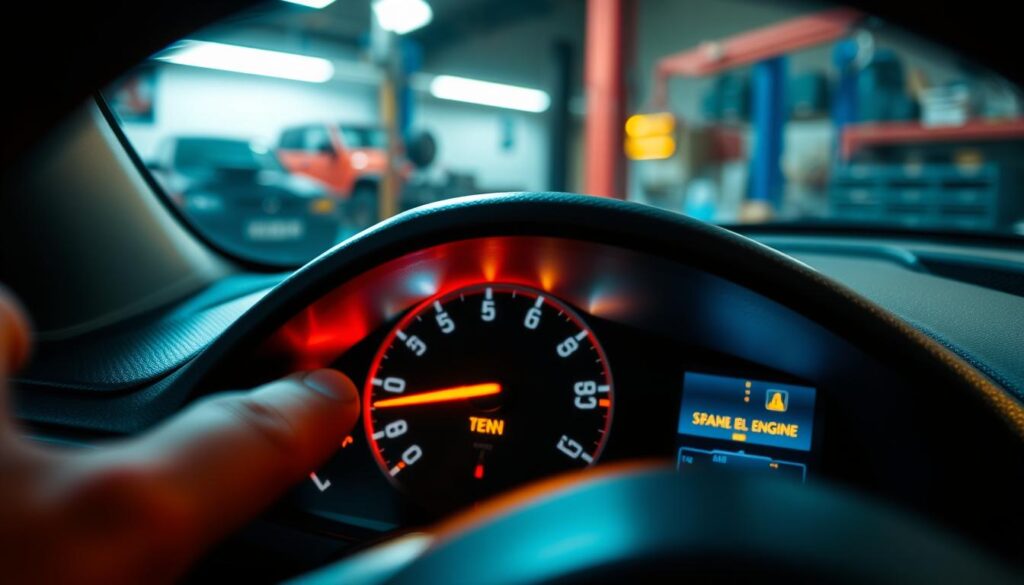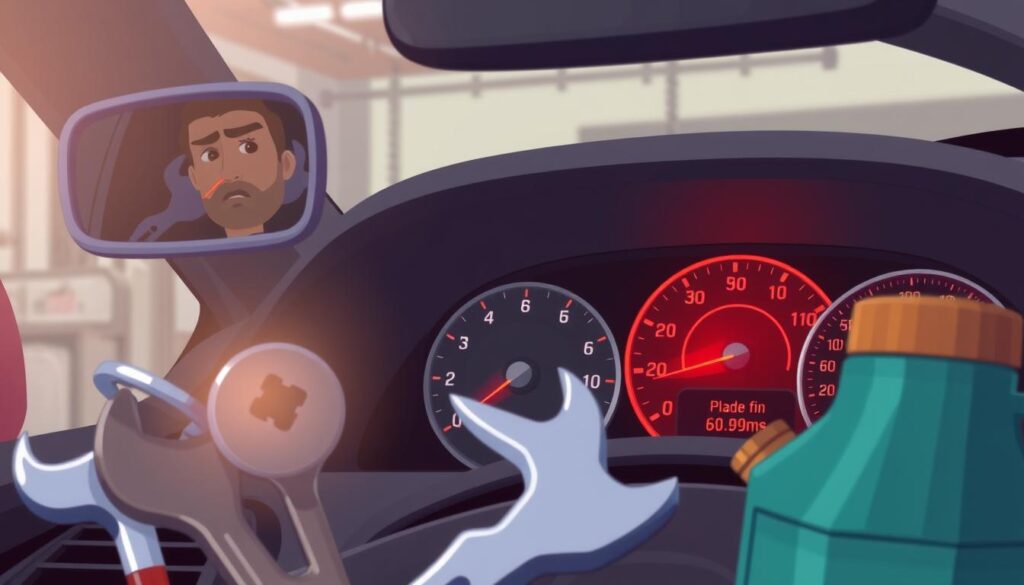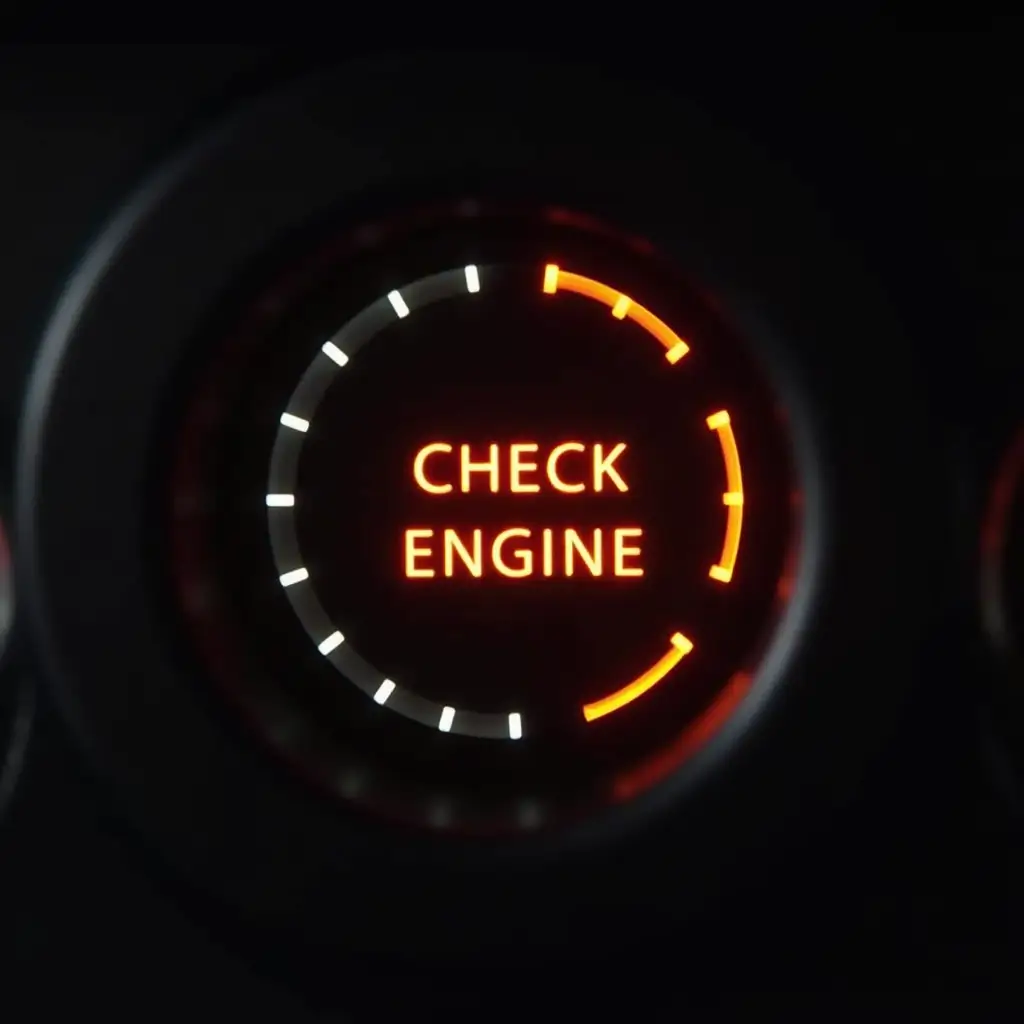As you drive, you notice the orange or red glow on your dashboard. The check engine light is on, and you feel worried. What’s causing this, and should you be concerned? The check engine light is a key warning that needs your quick attention.
Your car’s computer is always watching, ready to tell you if something’s off. It might be a small problem or something big. That light is your car’s way of saying, “Hey, I need a check-up.” If you ignore it, you could face bigger issues, like bad fuel efficiency or even legal trouble.
In This Guide
Understanding Your Vehicle’s Warning System
Your vehicle’s check engine light is a key warning sign. It tells you something might be wrong under the hood. Knowing what the different lights mean can help you fix problems fast.
Different Types of Check Engine Light Patterns
The check engine light can show steady or flashing. A steady light means a less urgent problem. But a flashing light warns of a serious issue that needs quick action.
- Steady check engine light: This shows a problem that needs fixing, but it’s not an emergency.
- Flashing check engine light: This means a big problem, like a misfiring engine. Driving with this light can damage your car, so fix it fast.
What the Colors Mean: Yellow vs. Red Warnings
The color of your check engine light tells you how serious the problem is. A yellow or amber light means a less serious issue. But a red light warns of a critical problem that needs immediate action.
- Yellow or amber check engine light: This usually means a problem that’s not urgent, but still needs fixing to avoid bigger issues.
- Red check engine light: This is a serious warning, like a major engine or emissions failure. If you see this, pull over and get your car checked by a pro right away.
By knowing what your check engine light means, you can keep your car running well. This helps avoid expensive repairs later.
Common Reasons Why Your Check Engine Light On
If your check engine light is on, it’s crucial to know why. Many things can cause this light to turn on, from a loose gas cap to serious issues like a bad oxygen sensor or a failed catalytic converter.
A loose or damaged gas cap is a common problem. If the gas cap isn’t tight, air gets into the fuel system. This lowers fuel pressure and turns on the check engine light. Fixing this is simple, usually just tightening or replacing the gas cap.
- Loose or damaged gas cap
- Faulty oxygen sensor
- Catalytic converter issues
- Misfiring engine
A bad oxygen sensor is another common reason. These sensors check the air-fuel mix in the engine. If they fail, the engine runs less efficiently, wasting fuel and possibly causing more emissions.
Problems with the catalytic converter can also light up the check engine light. This part helps reduce harmful emissions. If it’s clogged or damaged, it can hurt the car’s performance and turn on the light.
Lastly, a misfiring engine can cause the light to come on. Misfires can happen for many reasons, like bad spark plugs or worn-out ignition coils. This can make the car run poorly, use more fuel, and turn on the check engine light.
If your check engine light is on, you should get it checked right away. Ignoring it can cause more damage and cost more to fix later. Knowing the common causes helps you find and fix the problem, keeping your car running well.
The Role of Your Vehicle’s Oxygen Sensor
Your vehicle’s oxygen sensors are key to keeping your fuel efficient and engine running well. They check the air-fuel mix in your engine. This info helps the engine control unit (ECU) adjust fuel and air delivery. Working right, these sensors can lower your check engine light repair and check engine light cost by making your car more efficient.
How Oxygen Sensors Affect Fuel Efficiency
Oxygen sensors look at the exhaust gases in your engine. They find out how much oxygen is in the exhaust. Then, they tell the ECU to adjust the fuel-to-air mix. This keeps your engine running smoothly, saving fuel and cutting down on emissions.
Signs of a Failing O2 Sensor
- Decreased fuel efficiency
- Rough idling or stalling
- Misfiring or engine hesitation
- Increased emissions and failed smog tests
- Illuminated check engine light
Replacement Costs and Timing
Replacing an oxygen sensor can cost between $150 to $300, depending on your car. It’s best to replace them every 60,000 to 90,000 miles. Or, follow your manufacturer’s advice to keep your engine and fuel efficiency at their best.
| Sensor Type | Average Replacement Cost |
|---|---|
| Upstream Oxygen Sensor | $100 – $200 |
| Downstream Oxygen Sensor | $150 – $300 |
Knowing how oxygen sensors work and spotting problems early can help keep your car running well. This can save you money on check engine light repair and check engine light cost in the long run.
Loose or Damaged Gas Cap Issues
A loose or damaged gas cap can cause your check engine light to turn on. Your car’s computer checks the fuel system, and a bad gas cap can set off the light. This happens because a faulty cap lets air into the fuel system, messing with the air-to-fuel ratio.
Fixing this problem is usually easy and cheap. Just tighten the gas cap or replace it if it’s broken. This can fix the issue and turn off the check engine light. Here’s how to handle check engine light reset and check engine light repair for a loose or damaged gas cap:
- Find your car’s gas cap, which is usually on the driver’s side.
- Tighten the gas cap until it clicks. Make sure it’s tight.
- If the gas cap is cracked or broken, get a new one.
- Drive your car for a few miles after tightening or replacing the cap. This lets the system reset.
- If the light is still on, you might need to use an OBD-II scanner to clear the code.
Fixing a loose or damaged gas cap can solve the check engine light problem fast and cheap. It’s key to keep the gas cap tight to protect your car’s fuel system and prevent more problems later.

| Symptom | Cause | Solution |
|---|---|---|
| Check engine light on | Loose or damaged gas cap | Tighten or replace gas cap |
| Decreased fuel efficiency | Loose or damaged gas cap | Tighten or replace gas cap |
| Evaporative emissions system issues | Loose or damaged gas cap | Tighten or replace gas cap |
“A properly functioning gas cap is essential for maintaining the integrity of your vehicle’s fuel system and avoiding costly repairs down the line.”
Fixing a loose or damaged gas cap can solve the check engine light problem quickly and cheaply. It’s important to keep the gas cap tight to protect your car’s fuel system and prevent more problems.
Catalytic Converter Problems and Solutions
Your car’s catalytic converter is key to cutting down harmful emissions. It helps keep the air clean. But, it can sometimes go wrong, causing the check engine light to come on. Knowing the signs of trouble, the harm it can cause, and how to fix it is important.
Signs of Converter Failure
Here are some signs your catalytic converter might be failing:
- Reduced fuel efficiency
- Unusual engine sounds, such as rattling or knocking
- Difficulty accelerating or a noticeable decrease in power
- Pungent exhaust odor, often described as rotten eggs
Environmental Impact and Legal Requirements
A bad catalytic converter can harm the environment. It lets harmful pollutants into the air. Many places have strict rules about emissions. Ignoring a bad converter can lead to big fines.
Fixing it quickly helps the planet and keeps your car legal.
Replacement Options and Costs
When your catalytic converter needs a replacement, you have choices. The check engine light repair and check engine light cost depend on your car and the repair. Sometimes, a used or aftermarket converter is cheaper than a new one.
“A well-functioning catalytic converter is essential for maintaining the health of our environment and ensuring your vehicle’s compliance with emissions standards.”
Using OBD-II Scanners for Diagnostics
Figuring out why your check engine light is on can be tough. But, OBD-II scanners make it easier. These tools let you see what’s going on inside your car. They help you find out why the light is on.
OBD-II scanners are for everyone, from mechanics to car owners. They read trouble codes in your car’s computer. This way, you know exactly what’s wrong. By connecting an OBD-II scanner to your car, you get lots of useful info. This includes how your engine is doing, emissions, and even how much fuel you’re using.
| Feature | Professional-Grade OBD-II Scanner | Consumer-Grade OBD-II Scanner |
|---|---|---|
| Functionality | Advanced diagnostic capabilities, including live data monitoring and in-depth vehicle analysis | Basic diagnostics, trouble code reading, and basic vehicle information |
| Compatibility | Works with a wide range of vehicle makes and models | May have limited compatibility with certain vehicle makes and models |
| Price | $200 to $1,000 or more | $20 to $100 |
| User Experience | Requires some technical knowledge to interpret the data | Typically more user-friendly with simple instructions and intuitive interfaces |
Using an check engine light scanner or check engine light diagnostics tool can save you time and money. It helps you find out why the light is on before you see a mechanic. This way, you can take better care of your car and understand its health better.
When to Visit a Professional Mechanic
Fixing your car’s check engine light can be tricky. Some problems are easy to solve yourself, but others need a pro. Knowing when to get help can save you time and money.
DIY vs. Professional Diagnosis
If you know a bit about cars and have an OBD-II scanner, you can try some fixes yourself. Issues like a loose gas cap or a bad oxygen sensor might be simple. But, if it’s something big like the engine or transmission, a certified mechanic is your best bet.
Average Repair Costs to Expect
- Check engine light diagnosis: $50 – $150
- Oxygen sensor replacement: $200 – $400
- Catalytic converter replacement: $1,000 – $2,500
- Engine control module (ECM) replacement: $800 – $1,200
Getting a pro to fix your check engine light repair might seem pricey. But, it’s often worth it to keep your car safe and running well. Trying to fix complex problems yourself can lead to bigger, more expensive issues.

If you’re unsure, it’s safer to get a trusted mechanic’s opinion. They have the skills and tools to find and fix the real problem. This way, you avoid costly mistakes and can drive safely again.
Preventive Maintenance Tips to Avoid Warning Lights
Keeping up with your car’s maintenance is crucial to avoid check engine light issues. Simple preventive steps can keep your car running well and prevent check engine light causes or check engine light repair needs.
Changing your oil and filters on time is essential. Skipping this can cause many problems, like bad fuel efficiency and engine damage. Always use the correct oil and replace air filters to keep your engine running great.
- Make sure to get regular tune-ups to check spark plugs, ignition coils, and other key parts.
- Check your tires often for the right air pressure and wear. Good tire care improves fuel use and handling.
- Listen for odd noises, vibrations, or performance changes. These might signal a problem that needs fixing.
| Preventive Maintenance Task | Recommended Frequency |
|---|---|
| Oil and Filter Change | Every 5,000-7,500 miles |
| Tire Rotation | Every 5,000-8,000 miles |
| Air Filter Replacement | Every 12,000-15,000 miles |
| Spark Plug Replacement | Every 30,000-60,000 miles |
By being consistent with these maintenance tasks, you can lower the risk of your check engine light coming on. Keeping your car in good shape saves you time, money, and stress from check engine light causes or check engine light repair issues later.
Conclusion
When you see the check engine light, it’s time to act fast. This light is a warning that something might be wrong with your car. It could be a small issue or a big one, like a problem with the oxygen sensor or catalytic converter.
Regular car checks and using an OBD-II scanner can help catch problems early. This way, you can avoid expensive repairs later. Some fixes you can do yourself, but for complex issues, it’s best to get a mechanic’s help.
Your car’s health is important for your safety and the safety of others. By keeping an eye on the check engine light and fixing problems quickly, you help make driving safer. This also helps the environment by reducing the need for costly repairs.

